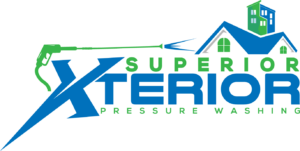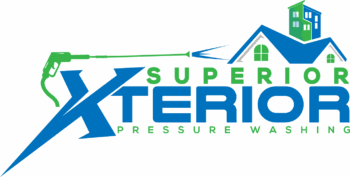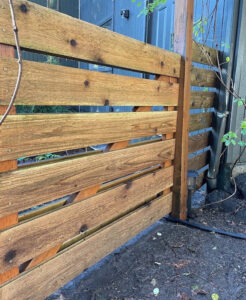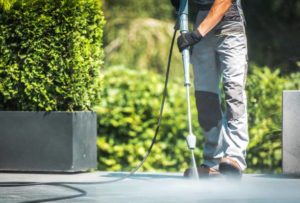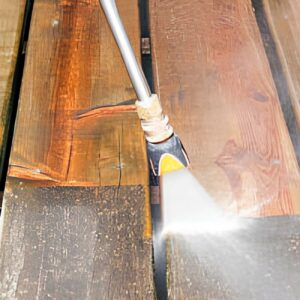Your home’s exterior is constantly exposed to the elements – rain, humidity, and changing temperatures create the perfect environment for mold and mildew to thrive. While these fungal growths might start as small, dark spots on your siding or roof, they can quickly spread and cause significant damage. Many homeowners assume mold and mildew are simply cosmetic issues, but the truth is, they pose serious risks to both your home’s structure and your family’s health.
If left untreated, mold and mildew can weaken building materials, leading to costly repairs. Worse, mold spores can become airborne and enter your home, aggravating allergies and respiratory conditions. The good news? Regular pressure washing can eliminate mold growth and prevent further problems before they escalate.
How Mold and Mildew Damage Your Home
Mold and mildew might seem like harmless stains at first, but they slowly eat away at your home’s exterior. They thrive in damp, shaded areas, especially on siding, decks, roofs, and driveways. Over time, their presence leads to structural damage, reduced energy efficiency, and even safety hazards.
One of the most common issues caused by mold is wood rot. Wooden decks, fences, and siding absorb moisture when mold and mildew are present, causing the wood to soften and break down. This can weaken your home’s structure, making repairs inevitable. Even non-wood materials like vinyl and stucco can suffer from mold buildup. Mold can seep into cracks, trapping moisture and leading to warping, discoloration, and deterioration.
Your roof is also at risk. Mold and mildew love to grow on shingles, particularly in damp climates. As mold spreads, it lifts shingles and weakens the roof’s protective barrier, making your home more vulnerable to leaks and water damage. In severe cases, neglected mold growth can shorten your roof’s lifespan, forcing you to replace it years earlier than expected.
The Health Risks of Mold on Your Home’s Exterior
Mold and mildew aren’t just bad for your home – they can also be hazardous to your health. While exterior mold might seem harmless, mold spores become airborne and can enter your home through windows, vents, and HVAC systems. Once inside, these spores circulate through the air and can cause a range of health problems, especially for those with allergies, asthma, or weakened immune systems.
Common symptoms of mold exposure include sneezing, coughing, congestion, and irritated eyes. In more severe cases, prolonged exposure can lead to respiratory infections, skin irritation, and worsened asthma symptoms. If you or your family members frequently experience allergy-like symptoms at home, exterior mold could be a contributing factor.
Mold and Mildew Reduce Curb Appeal and Property Value
A home covered in mold stains and mildew growth instantly looks older, neglected, and poorly maintained. If you’re planning to sell your home, first impressions matter. Buyers may assume a mold-covered home has underlying issues, making them hesitant to make an offer. Even if you’re not selling, curb appeal plays a role in your neighborhood’s appearance and your own satisfaction as a homeowner.
Mold and mildew on your driveway, siding, and roof can significantly lower your property’s value. Home inspectors often flag mold growth as a red flag, and potential buyers may use it as a reason to negotiate a lower price. Regular pressure washing helps keep your home looking fresh and well-kept, boosting both curb appeal and resale value.
Slippery Surfaces: A Hidden Danger on Driveways and Decks
Mold and mildew don’t just affect your home’s walls and roof—they also create hazardous conditions on the ground. Mold-covered driveways, sidewalks, patios, and decks become incredibly slippery, especially when wet. This increases the risk of slip-and-fall accidents, which can lead to serious injuries.
Wooden decks are particularly vulnerable because they absorb moisture, making them even more prone to becoming slippery and unstable. Mold and algae growth can cause the wood to decay, weakening the structure and creating a safety hazard. A quick pressure wash can remove mold from these surfaces, restoring grip and preventing dangerous falls.
The Best Way to Remove and Prevent Mold and Mildew
Pressure Washing: The Most Effective Solution
The fastest and most effective way to remove mold and mildew from your home’s exterior is pressure washing. Unlike scrubbing by hand, which can be time-consuming and ineffective, pressure washing blasts away mold, mildew, and dirt using high-powered water jets.
Professional soft washing (a low-pressure alternative) is the safest method for delicate surfaces like siding and roofs. It uses specialized cleaning solutions that not only remove mold but also prevent regrowth. This means your home stays mold-free for longer, without the risk of damage caused by high-pressure washing.
Additional Prevention Tips
While pressure washing is the best way to remove existing mold, prevention is key to keeping it from coming back. Here’s what you can do:
- Trim Trees and Shrubs – Allow more sunlight to reach shaded areas where mold thrives.
- Fix Leaky Gutters – Ensure water drains properly to prevent moisture buildup.
- Improve Airflow – Proper ventilation around your home’s exterior helps keep surfaces dry.
- Apply Mold-Resistant Coatings – Protective sealants on decks, siding, and driveways make it harder for mold to grow.
Protect Your Home – Schedule a Pressure Wash Today!
Mold and mildew are more than just an aesthetic problem – they can cause serious damage to your home and health. Regular pressure washing keeps your home safe, clean, and free from harmful buildup.
Don’t wait until the damage is done! Contact us today to schedule a professional pressure wash and keep your home in top condition.
